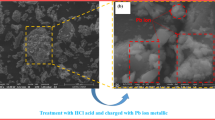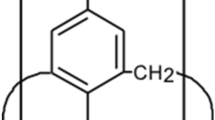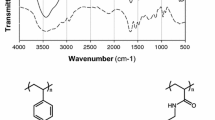Abstract
The synthesis of the poly(4-vinylpyridine-co-ethylvinylbenzene) resin is investigated and its performance to remove Cr(VI) from aqueous solutions is evaluated as a function of pH using batch and fixed bed column adsorptions. The rate of Cr(VI) removal is observed to increase as the pH solution shifts to acidic conditions due to an enhanced protonation of the 4-vinylpyridine group in the polymer, which favors its electrostatic attraction with Cr(VI) oxyanions. This finding is supported with Density Functional Theory (DFT) calculations, revealing that the interaction between \({\text{CrO}}_{4}^{{2 - }}\) (predominant species at pH < 6) and protonated 4VP is more favorable than a bond formed with \({\text{HCrO}}_{4}^{ - }\) species (pH > 6) due to a higher charge delocalization arising in the O atoms. Experimental isotherms are approximated with the Langmuir and Radke-Prausnitz adsorption models. This former approach generates the best fitting to the data, whereby it was incorporated into a nonlinear transient model to account for the Cr(VI) adsorption in a fixed bed, and evaluating its capacity to predict experimental adsorption data. The model enables to infer that the resin presents a fast kinetic for Cr(VI) sorption, and the Cr(VI) intra-particle diffusion across the adsorbent pores is the rate-determining step for sorption.











Similar content being viewed by others
Abbreviations
- \({A_s}\) :
-
Area of transversal section of the column (cm2)
- \({{\text{a}}_{\text{e}}}\) :
-
Mass transfer specific area (cm−1)
- \({C_e}\) :
-
The equilibrium concentrations in the liquid phase (mg Cr L−1)
- \({C_0}\) :
-
The initial concentrations in the liquid phase (mg Cr L−1)
- \({C_{{\text{Cr}}}}\) :
-
Concentration of Cr(VI) in the bulk fluid phase (mg L−1)
- \(C_{{{\text{Cr}}}}^{0}\) :
-
Feed concentration of Cr(VI) in the bulk fluid phase (mg L−1)
- \({C_{{\text{Cr}}\left( \delta \right)}}\) :
-
Concentration of Cr(VI) in the layer (mg L−1)
- \({C_t}\) :
-
The effluent Cr(VI) concentrations through the bed (mg L−1)
- \(~{D_{ax}}\) :
-
Axial dispersion coefficient in the fluid phase (cm2 min−1)
- \({d_p}\) :
-
Equivalent diameter of the adsorbent particle (cm)
- \({D_m}\) :
-
Molecular diffusivity of Cr(VI) (cm2 min−1)
- \(F\) :
-
Volumetric flow rate (cm3 min−1)
- \(G\) :
-
Mass flux (g cm−2 min−1)
- \({k_f}\) :
-
Mass transfer coefficient in external liquid film (cm min−1)
- \(~{K_L}\) :
-
Constant related to the free adsorption energy (L mg−1)
- \({k_s}\) :
-
Mass transfer coefficient in the adsorbent (min−1)
- \({L_c}\) :
-
Fixed bed length (cm)
- \(~{K_{RPIII}}\) :
-
Radke-Prausnitz constant
- \(~m\) :
-
Mass of resin (g)
- \(n\) :
-
Dimensionless exponent
- \({n_s}\) :
-
Number of experimental data points
- \(Q\) :
-
Water swelling capacity
- \(q\) :
-
Average concentration of Cr(VI) adsorbed in the adsorbent (mg g−1)
- \({q_e}\) :
-
Amount of chromium adsorbed per unit weight of resin at equilibrium (mg g−1)
- \(~{q_{max}}\) :
-
Maximal adsorption capacity (mg g−1)
- \(~{q_{mRPIII}}\) :
-
Constant Radke-Prausnitz
- \({q_t}\) :
-
Total Cr(VI) adsorbed on the copolymer at different time (mg g−1)
- \({r_{ads}}\) :
-
Chromium adsorption rate (g g−1 min−1)
- \(S\) :
-
Least squared error function
- \(t\) :
-
Time (min)
- \(u\) :
-
Velocity (cm min−1)
- \(V\) :
-
Volume of the solution (L)
- \(W\) :
-
Dimensionless parameter
- \({W_s}\) :
-
Weight of the swollen resin (g)
- \({W_d}\) :
-
Weight of the dried resin (g)
- \({\beta _{RPIII}}\) :
-
Radke-Prausnitz exponent
- \({{{{\rho}}}_{{f}}}\) :
-
Density of the fluid phase (g cm−3)
- \({{{{\rho}}}_{{b}}}\) :
-
Density of the bed (g L−1)
- \(\epsilon\) :
-
Column void fraction
- \({{{\mu}}}\) :
-
Viscosity of the fluid phase (g cm−1 min−1)
References
Arslan, M., Yigitoglu, M., Soysal, A.: Removal of chromium(VI) from aqueous solutions using poly(4-vinyl pyridine) beads. J. Appl. Polym. Sci. 101, 2865–2870 (2006). https://doi.org/10.1002/app.2333
Auki, S.K., Neufeld, R.D.: Use of activated carbon for the recovery of chromium from industrial wastewaters. J. Chem. Tech. Biotechonol. 70(1), 3–8 (1997)
Bai, R.S., Abraham, T.E.: Studies on chromium(VI) adsorption–desorption using immobilized fungal biomass. Bioresour. Technol. 87, 17–26 (2003). https://doi.org/10.1016/S0960-8524(02)00222-5
Bajpai, J., Shrivastava, R., Bajpai, A.K.: Dynamic and equilibrium studies on adsorption of Cr(VI) ions onto binary bio-polymeric beads of cross linked alginate and gelatin. Colloids Surf. A 236, 81–90 (2004). https://doi.org/10.1016/j.colsurfa.2004.01.021
Becke, A.D.: Density-functional thermochemistry. III. The role of exact exchange. J. Chem. Phys. 98, 5648 (1993). https://doi.org/10.1063/1.464913
Borba, C.E., Guirardello, R., Silva, E.A., Veit, M.T., Tavares, C.R.G.: Removal of nickel(II) ions from aqueous solution by biosorption in a fixed bed column: experimental and theoretical breakthrough curves. Biochem. Eng. J. 30, 184–191 (2006). https://doi.org/10.1016/j.bej.2006.04.001
Cardoso, J., Ortiz-Palacios, J., Manero, O.: Production of microporous resins for heavy-metal removal II, functionalized polymers. J. Appl. Polym. Sci. 107, 3644–3653 (2008). https://doi.org/10.1002/app.27422
Cerato, A., Lutenegger, A.: Determination of surface area of fine-grained soils by the ethylene glycol monoethyl ether (EGME) method. Geotech. Test. J. 25, 315–321 (2002). https://doi.org/10.1520/GTJ11087J
Chandat, M., Rempel, G.L.: Poly (4-vinylpyridine) gel-coated on silica. High capacity and fast kinetics in uranyl sulfate recovery. Ind. Eng. Chem. Res. 32, 726–732 (1993). https://doi.org/10.1021/ie00016a020
Cruz-Díaz, M.R., Rivero, E.P., Almazán-Ruiz, F.J., Torres-Mendoza, A., González, I.: Design of a new FM01-LC reactor in parallel plate configuration using numerical simulation and experimental validation with residence time distribution (RTD). Chem. Eng. Process. 85, 145–154 (2014). https://doi.org/10.1016/j.cep.2014.07.010
da Silva, E.A., Cossich, E.S., Tavares, C.G., Cardozo Filho, L., Guirardello, R.: Modeling of copper(II) biosorption by marine alga Sargassum sp. In fixed-bed column. Process Biochem. 38, 791/799 (2002). https://doi.org/10.1016/S0032-9592(02)00231-5
Deltombe, de Zoubov N., Pourbaix, M.: Atlas of Electrochemical Equilibria in Aqueous Solutions, 2nd edn. NACE, Houston (1974)
Deng, S., Bai, R.: Removal of trivalent and hexavalent chromium with aminated polyacrylonitrile fibers: performance and mechanisms. Water Res. 38, 2424–2432 (2004). https://doi.org/10.1016/j.watres.2004.02.024
Deng, S., Renbi, B.: Removal of trivalent and hexavalent chromium with aminated polyacrylonitrile fibers: performance and mechanisms. Water Res. 38, 2424–2432 (2004). https://doi.org/10.1016/j.watres.2004.02.024
Dhal, B., Thatoi, H.N., Das, N.N., Pandey, B.D.: Chemical and microbial remediation of hexavalent chromium from contaminated soil and mining/ metallurgical solid waste: a review. J. Hazard. Mater. 250, 272–291 (2013). https://doi.org/10.1016/j.jhazmat.2013.01.048
Donghee, P., Yeoung-Sang, Y., Ji, H.J., Jong, M.P.: Mechanism of hexavalent chromium removal by dead fungal biomass of Aspergillus niger. Water Res. 39, 533–540 (2005a). https://doi.org/10.1016/j.watres.2004.11.002
Donghee, P., Yeoung-Sang, Y., Jong, M.P.: Use of dead fungal biomass for the detoxification of hexavalent chromium: screening and kinetics. Process Biochem. 40, 2559–2565 (2005b). https://doi.org/10.1016/j.procbio.2004.12.002
Edebali, S., Pehlivan, E.: Evaluation of Amberlite IRA96 and Dowex 1 × 8 ionexchange resins for the removal of Cr(VI) from aqueous solution. Chem. Eng. J 161, 161–166 (2010). https://doi.org/10.1016/j.cej.2010.04.059
Erbay, E., Okay, O.: Macroporous styrene–divinylbenzene copolymers: formation of stable porous structures during the copolymerization. Polym. Bull. 41, 379–385 (1998). https://doi.org/10.1007/s002890050377
Foo, K.Y., Hameed, B.H.: Insights into the modeling of adsorption isotherm systems. Chem. Eng. J. 156(1), 2–10 (2010). https://doi.org/10.1016/j.cej.2009.09.013
Galán, B., Castañeda, D., Ortiz, I.: Removal and recovery of Cr(VI) from polluted ground waters: a comparative study of ion-exchange technologies. Water Res. 39, 4317–4324 (2005). https://doi.org/10.1016/j.watres.2005.08.015
Gang, D., Banerji, S.K., Clevenger, T.E.: Modified poly(4-vinylpyridine) coated silica gel. Fast kinetics of diffusion-controlled sorption of chromium(VI). Ind. Eng. Chem. Res. 40, 1200–1204 (2001). https://doi.org/10.1021/ie000771b
Gode, F., Pehlivan, E.: Removal of Cr(VI) from aqueous solution by two Lewatitanion exchange resins. J. Hazard. Mater. 119, 175–182 (2005). https://doi.org/10.1016/j.jhazmat.2004.12.004
Gokmen, M.T., Du Prez, F.E.: Porous polymer particles-A comprehensive guide to synthesis, characterization, functionalization and applications. Prog. Polym. Sci. 37, 365–405 (2012). https://doi.org/10.1016/j.progpolymsci.2011.07.006
Gupta, V.K., Gupta, M., Sharma, S.: Process development for the removal of lead and chromium from aqueous solutions using red mud: an aluminium industry waste. Water Res. 35(1), 1125–1134 (2001). https://doi.org/10.1016/S0043-1354(00)00389-4
Horák, D., Beneš, M.J., Gumargalieva, K., Zaikov, G.: A novel highly copper(II)-selective chelating ion exchanger based on poly(glycidyl methacrylate-co-ethylene dimethacrylate) beads modified with aspartic acid derivative. J. Appl. Polym. Sci. 80, 913–916 (2001). https://doi.org/10.1002/app.1170
Iadicicco, N., Paduano, L., Vitagliano, V.: Diffusion coefficients for the system potassium chromate–water at 25 °C. J. Chem. Eng. Data 411, 529–533 (1996). https://doi.org/10.1021/je9502861
Iyengar, S.S., Schlegel, H.B., Millam, J.M., Voth, G.A., Scuseria, G.E., Frisch, M.J.: Ab initio molecular dynamics: propagating the density matrix with Gaussian orbitals. II. Generalizations based on mass-weighting, idempotency, energy conservation and choice of initial conditions. J. Chem. Phys. 115, 10291–10302 (2001). https://doi.org/10.1063/1.1416876
Jacukowsky-Sobala, I., Ocinski, D., Kociołek-Balawejder, E.: Synthesis and evaluation of a novel hybrid polymer containing manganese and iron oxides as a sorbent for As(III) and As(V) removal. Ind. Eng. Chem. Res. 52(19), 6453–6461 (2013). https://doi.org/10.1021/ie400478x
Kim, K., Lee, K.S., Lee, J.H.: Bilevel optimizing control structure for a simulated moving bed process based on a reduced-order model using the cubic spline collocation method. Ind. Eng. Chem. Res. 49, 3689–3699 (2010). https://doi.org/10.1021/ie901121y
Kobya, M.: Removal of Cr(VI) from aqueous solutions by adsorption onto hazelnut shell activated carbon: kinetic and equilibrium studies. Bioresour. Technol. 91, 317–321 (2004). https://doi.org/10.1016/j.biortech.2003.07.001
Kocaoba, S., Akcin, G.: A kinetic investigation of chromium. Adsorption 9, 143–151 (2003). https://doi.org/10.1023/A:1024293310492
Kowalski, Z.: Treatment of chromic tannery wastes. J. Hazard. Mater. 37, 137–141 (1994). https://doi.org/10.1016/0304-3894(94)85042-9
Kun, K.A., Kunin, R.: Macroreticular resins: III. Formation of macroreticular styrene–divinylbenzene copolymers. J. Polym. Sci. A 6, 2689–2696 (1968). https://doi.org/10.1002/pol.1968.150061001
Mohammad, M.S., Daud, W.M.A.W., Shamiri, A.: A review of mathematical modeling of fixed-bed columns for carbon dioxide adsorption. Chem. Eng. Res. Des. 92, 961–988 (2014). https://doi.org/10.1016/j.cherd.2013.08.018
Mustafa, S., Ahmad, T., Naeem, A., Shah, K., Waseem, M.: Kinetics of chromium ion removal from tannery wastes using amberlite IRA-400 Cl and its hybrids. Water Air Soil Pollut. 210, 43–50 (2010). https://doi.org/10.1007/s11270-009-0221-7
Nakano, Y., Kenji, T., Toshiro, T.: Adsorption mechanism of hexavalent chromium by redox within condensed-tannin gel. Water Res. 35, 496–500 (2001). https://doi.org/10.1016/S0043-1354(00)00279-7
Nodeli, A., Hajiebrahimi, M., Parvazinia, M., Shahrokhi, M., Abedini, H.: Correlations for prediction of specific surface area and bulk and apparent densities of porous styrene-divinylbenzene copolymers. J. Appl. Polym. Sci. 120:1942–1949 (2011). https://doi.org/10.1002/app.33275
Ortiz-Palacios, J., Cardoso, J., Manero, O.: Production of macroporous resins for heavy-metal removal I, nonfunctionalized polymers. J. Appl. Polym. Sci. 107, 2203–2210 (2008). https://doi.org/10.1002/app.27243
Pehlivan, E., Cetin, S.: Sorption of Cr(VI) ions on two Lewatit-anion exchange resins and their quantitative determination using UV–Visible spectrophotometer. J. Hazard. Mater. 163, 448–453 (2009). https://doi.org/10.1016/j.jhazmat.2008.06.115
Polowczyk, I., Urbano, B.F., Rivas, B.L., Bryjak, M., Kabay, N.: Equilibrium and kinetic study of chromium sorption on resins with quaternary ammonium and N-methyl-d-glucamine groups. Chem. Eng. J. 284, 395–404 (2016). https://doi.org/10.1016/j.cej.2015.09.018
Raji, C., Anirudhan, T.S.: Batch Cr(VI) removal by polyacrylamide-grafted sawdust: kinetics and thermodynamics. Water Res. 32, 3772–3780 (1998). https://doi.org/10.1016/S0043-1354(98)00150-X
Rivera, F.F., Cruz-Díaz, M.R., Rivero, E.P., González, I.: Analysis and interpretation of residence time distribution experimental curves in FM01-LC reactor using axial dispersion and plug dispersion exchange models with closed–closed boundary conditions. Electrochim. Acta 56, 361–371 (2010). https://doi.org/10.1016/j.electacta.2010.08.069
Ruotolo, L.A.M., Gubulin, J.C.: Chromium(VI) reduction using conducting polymer films. React. Funct. Polym. 62, 141–151 (2005). https://doi.org/10.1016/j.reactfunctpolym.2004.11.004
Sandhya, B., Tonni, A.K.: Cr(VI) removal from synthetic wastewater using coconut shell charcoal and commercial activated carbon modified with oxidizing agents and/or chitosan. Chemosphere 54, 951–967 (2004). https://doi.org/10.1016/j.chemosphere.2003.10.001
Schlegel, H.B., Millam, J.M., Iyengar, S.S., Voth, G.A., Daniels, A.D., Scuseria, G.E., Frisch, M.J.: Ab initio molecular dynamics: propagating the density matrix with Gaussian orbitals. J. Chem. Phys. 114, 9758–9763 (2001). https://doi.org/10.1063/1.1372182
Schlegel, H.B., Iyengar, S.S., Li, X., Millam, J.M., Voth, G.A., Scuseria, G.E., Frisch, M.J.: Ab initio molecular dynamics: propagating the density matrix with Gaussian orbitals. III. Comparison with born–oppenheimer dynamics. J. Chem. Phys. 117, 8694–8704 (2002). https://doi.org/10.1063/1.1514582
Sherrington, D.C.: Preparation, structure and morphology of polymer supports. Chem. Commun. 21, 2275–2286 (1998). https://doi.org/10.1039/A803757D
Shi, T., Wang, Z., Liu, Y., Jia, S., Changming, D.: Removal of hexavalent chromium from aqueous solutions by D301, D314 and D354 anion-exchange resins. J. Hazard. Mater. 161, 900–906 (2009). https://doi.org/10.1016/j.jhazmat.2008.04.041
Singh, V.K., Tiwari, P.N.:(1997) Removal and recovery of chromium(VI) from industrial waste water. J. Chem. Tech. Biotechnol. 69, 376–382. https://doi.org/10.1002/(SICI)1097-4660(199707)69:3<376::AIDJCTB714>3.0.CO;2-F
Soo-Jin, P., Young-Mi, K.: Influence of anodic treatment on heavy metal ion removal by activated carbon fibers. J. Colloid. Interface Sci. 278, 276–281 (2004). https://doi.org/10.1016/j.jcis.2004.06.004
Sugii, A., Ogawa, N., Harada, K., Nishimura, K.: Metal sorption of macroreticular poly(4-vinylpyridine) resins cross-linked with oligo(ethylene glycol dimethacrylates). Anal. Sci. 4, 399–402 (1988). https://doi.org/10.2116/analsci.4.399
Tomasi, J., Mennucci, B., Cammi, R.: Quantum mechanical continuum solvation models. Chem. Rev. 105, 2999–3093 (2005). https://doi.org/10.1021/cr9904009
Wang, C.C., Chen, C.Y., Chang, C.Y.: Synthesis of chelating resins with iminodiacetic acid and its wastewater treatment application. J. Appl. Polym. Sci. 84, 1353–1362 (2002). https://doi.org/10.1002/app.10243
World Health Organization: Guidelines for Drinking-Water Quality, Vol. 1. World Health Organization, Geneva (2008)
Yasmine, A.O., Malika, C., Abdeltif, A., Aicha, B.: Sorption of hexavalent chromium metal onto Amberlite IRA 410: equilibrium isotherms and kinetic studies. Desalin. Water Treat. 38, 409–415 (2012). https://doi.org/10.1080/19443994.2012.664414
Yiğitoğlu, M., Arslon, M.: Adsorption of hexavalent chromium from aqueous solutions using 4-vinyl pyridine grafted poly(ethylene terephthalate) fibers. Polym. Bull. 55, 259–268 (2005). https://doi.org/10.1007/s00289-005-0440-z
Yilmaz, E., Küçükyavuz, Z.: Monomer reactivity ratios of styrene-4-vinylpyridine copolymers at low and high conversions. Polymer 34, 145–149 (1993). https://doi.org/10.1016/0032-3861(93)90297-N
Acknowledgements
This work was supported by the Mexican Council for Science and Technology (CONACyT, Grant Number CB-220232).
Author information
Authors and Affiliations
Corresponding author
Rights and permissions
About this article
Cite this article
Arcos-Casarrubias, J.A., Cruz-Díaz, M.R., Cardoso-Martínez, J. et al. Chromium adsorption into a macroporous resin based on vinylpyridine–divinylbenzene copolymers: thermodynamics, kinetics, and process dynamic in a fixed bed column. Adsorption 24, 105–120 (2018). https://doi.org/10.1007/s10450-017-9925-y
Received:
Revised:
Accepted:
Published:
Issue Date:
DOI: https://doi.org/10.1007/s10450-017-9925-y




